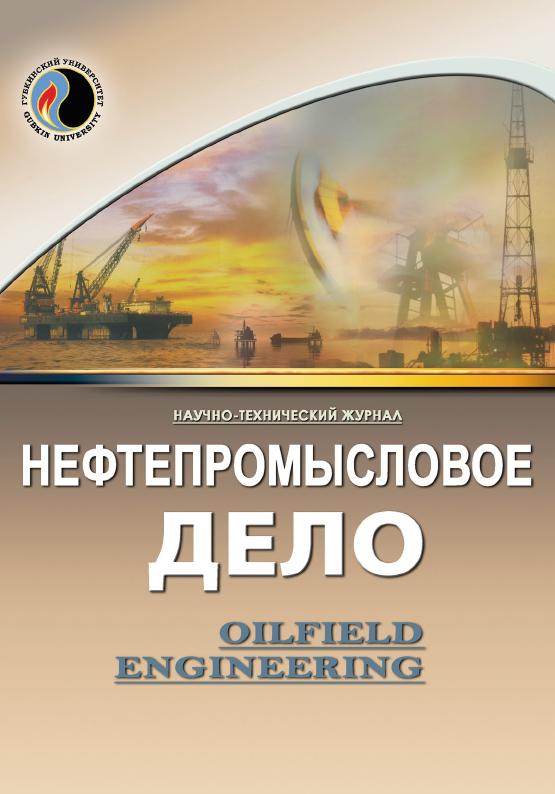Generalizations for limit pressures of production wells of terrigenic reservoirs of PJSC "Tatneft" 17 Egorov D.S., Mikhailov N.N. Technological factors influence on wells flow-rate dynamics in the Bazhenov formation deposits
UDC: 622.276.031:622.276.346
DOI: 10.33285/0207-2351-2023-6(654)-17-22
Authors:
IKTISANOV VALERIY A. 1
1,
MUSABIROVA NURIYA KH.1,
BAYGUSHEV ANDREY V.1,
CHIRKUNOV ALEXANDER P.2,
BRESLER LIYA KH.3
1 TatNIPIneft, Bugulma, Russia
2 Tatneft-Dobycha, Almetyevsk, Russia
3 Kazan (Volga Region) Federal University, Kazan, Russia
Keywords: limit pressures, maximum flow rate, indicator diagram, effective pressure, gas-oil ratio
Annotation:
With a decrease in bottomhole pressure in producing wells, along with a well productivity decrease, the existence of a maximum flow rate is often observed. This maximum corresponds to the limit pressure, below which the bottomhole pressure decrease in is impractical. The task of establishing the limit pressure based on the results of hydrodynamic studies and its dependence on the main determining factors is of direct practical importance. First of all, it is caused by the fact that fixing limit bottomhole pressures is the simplest and cheapest way to increase oil production compared to various methods of influencing the formation and bottomhole zone.
Based on the results of studies, using multiple regression, the main parameters that affect the ultimate pressure of production wells, namely, effective pressure, reservoir pressure (sometimes the ratio of saturation pressure to reservoir pressure), water cut, and skin-factor, were revealed. Parameters such as saturation pressure, clay content, Poisson’s ratio have little effect on improving the accuracy of limit pressure description. Multiple regression formulas for limit pressure calculation are proposed.
A decrease of the limit pressure with an increase of the effective pressure was found, which can be explained by cracking of the area close to the wellbore, under the influence of the stress state increase, since otherwise the effective pressure increase should worsen the filtration parameters and increase the limit pressure.
It is shown that the water cut increase leads to the limit pressure increase, which also contradicts the established opinion, since it is believed that the free gas decrease in should reduce the limit pressure.
It is noted that the skin factor decrease, along with the filtration resistance decrease, makes it possible to reduce the limit pressure and thereby to additionally increase the well flow rate.
Directions for further development of this topic are proposed.
Bibliography:
1. Vogel J.V. Inflow performance relationships for solution gas drive wells // J. of Petroleum Technology. – 1968. – Vol. 20, № 1. – P. 83–92. – SPE Paper 1476. – DOI: 10.2118/1476-PA
2. Fetkovich M.J. The isochronal testing of oil wells // SPE Paper 4529 presented at the Fall Meeting of the Society of Petroleum Engineers of AIME, Las Vegas, NV, 30 Sep.–3 Oct. 1973. – DOI: 10.2118/4529-MS
3. Diyashev R.N., Kosterin A.V., Skvortsov E.V. Fil’tratsiya zhidkosti v deformiruemykh neftyanykh plastakh. – Kazan’: Izd-vo Kazanskogo matematicheskogo obshchestva, 1999. – 238 s.
4. Mishchenko I.T. Skvazhinnaya dobycha nefti. – M.: Izd. tsentr RGU nefti i gaza im. I.M. Gubkina, 2015. – 448 s.
5. Utochnenie predel’no dopustimykh zaboynykh davleniy dlya karbonatnykh i terrigennykh kollektorov mestorozhdeniy PAO "Tatneft’" / V.A. Iktisanov, N.Kh. Musabirova, A.V. Baygushev, K.F. Shipilova // Neft. khoz-vo. – 2019. – № 7. – S. 36–39.
6. Karev V.I., Kovalenko Yu.F. Zavisimost’ pronitsaemosti prizaboynoy zony plasta ot depressii i konstruktsii zaboev dlya razlichnykh tipov gornykh porod // Tekhnologii TEK. – 2006. – № 6. – S. 59–63.
7. Kovalenko Yu.F. Geomekhanika neftyanykh i gazovykh skvazhin: dis. … d-ra fiz.-mat. nauk. – M., 2012. – 314 s.
8. Iktisanov V.A., Baygushev A.V., Smotrikov N.A. Osobennosti fil’tratsii v karbonatnykh otlozheniyakh, opredelennye po dannym issledovaniy nagnetatel’nykh skvazhin // Neft. khoz-vo. – 2022. – № 2. – S. 74–78.
9. Brent R.P. Algorithms for Minimization without Derivatives. – Chapters 3, 4. – Englewood Cliff, NJ: Prentice-Hall, 1973.

